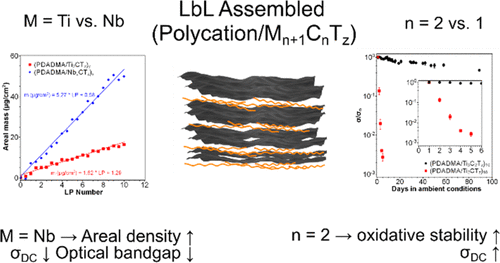Our official English website, www.x-mol.net, welcomes your feedback! (Note: you will need to create a separate account there.)
Electronic and Optical Property Control of Polycation/MXene Layer-by-Layer Assemblies with Chemically Diverse MXenes
Langmuir ( IF 3.9 ) Pub Date : 2021-09-15 , DOI: 10.1021/acs.langmuir.1c01904 Ian J Echols 1 , Hyosung An 1 , Junyeong Yun 1 , Kasturi T Sarang 1 , Ju-Hyun Oh 1 , Touseef Habib 1 , Xiaofei Zhao 1 , Huaixuan Cao 1 , Dustin E Holta 2 , Miladin Radovic 2 , Micah J Green 1, 2 , Jodie L Lutkenhaus 1, 2
Langmuir ( IF 3.9 ) Pub Date : 2021-09-15 , DOI: 10.1021/acs.langmuir.1c01904 Ian J Echols 1 , Hyosung An 1 , Junyeong Yun 1 , Kasturi T Sarang 1 , Ju-Hyun Oh 1 , Touseef Habib 1 , Xiaofei Zhao 1 , Huaixuan Cao 1 , Dustin E Holta 2 , Miladin Radovic 2 , Micah J Green 1, 2 , Jodie L Lutkenhaus 1, 2
Affiliation

|
MXenes, 2D nanomaterials derived from ceramic MAX phases, have drawn considerable interest in a wide variety of fields including energy storage, catalysis, and sensing. There are many possible MXene compositions due to the chemical and structural diversity of parent MAX phases, which can bear different possible metal atoms “M”, number of layers, and carbon or nitrogen “X” constituents. Despite the potential variety in MXene types, the bulk of MXene research focuses upon the first MXene discovered, Ti3C2T. With the recent discovery of polymer/MXene multilayer assemblies as thin films and coatings, there is a need to broaden the accessible types of multilayers by including MXenes other than Ti3C2Tz; however, it is not clear how altering the MXene type influences the resulting multilayer growth and properties. Here, we report on the first use of MXenes other than Ti3C2Tz, specifically Ti2CTz and Nb2CTz, for the layer-by-layer (LbL) assembly of polycation/MXene multilayers. By comparing these MXenes, we evaluate both how changing M (Ti vs Nb) and “n” (Ti3C2Tzvs Ti2CTz) affect the growth and properties of the resulting multilayer. Specifically, the aqueous LbL assembly of each MXene with poly(diallyldimethylammonium) into films and coatings is examined. Further, we compare the oxidative stability, optoelectronic properties (refractive index, absorption coefficient, optical conductivity, and direct and indirect optical band gaps), and the radio frequency heating response of each multilayer. We observe that MXene multilayers with higher “n” are more electrically conductive and oxidatively stable. We also demonstrate that Nb2CTz containing films have lower optical band gaps and refractive indices at the cost of lower electrical conductivities as compared to their Ti2CTz counterparts. Our work demonstrates that the properties of MXene/polycation multilayers are highly dependent on the choice of constituent MXene and that the MXene type can be altered to suit specific applications.
中文翻译:

具有化学多样性 MXene 的聚阳离子/MXene 逐层组件的电子和光学性能控制
MXenes 是一种源自陶瓷 MAX 相的二维纳米材料,在包括能量存储、催化和传感在内的广泛领域引起了极大的兴趣。由于母体 MAX 相的化学和结构多样性,有许多可能的 MXene 成分,它们可以带有不同的可能金属原子“M”、层数以及碳或氮“X”成分。尽管 MXene 类型有潜在的多样性,但大部分 MXene 研究都集中在第一个发现的 MXene Ti 3 C 2 T。随着最近发现的聚合物/MXene 多层组件作为薄膜和涂层,有必要扩大可访问性通过包含除 Ti 3 C 2 T z以外的 MXenes 的多层膜类型; 然而,尚不清楚改变 MXene 类型如何影响由此产生的多层生长和特性。在这里,我们报告了除 Ti 3 C 2 T z之外的 MXenes 的首次使用,特别是 Ti 2 CT z和 Nb 2 CT z,用于聚阳离子/MXene 多层膜的逐层 (LbL) 组装。通过比较这些 MXene,我们评估了 M(Ti与Nb)和“ n ”(Ti 3 C 2 T z与Ti 2 CT z) 影响所得多层的生长和性能。具体而言,研究了每种 MXene 与聚(二烯丙基二甲基铵)在薄膜和涂层中的水性 LbL 组装。此外,我们比较了每个多层膜的氧化稳定性、光电特性(折射率、吸收系数、光导率以及直接和间接光学带隙)以及射频加热响应。我们观察到具有更高“ n ”的MXene 多层膜更具有导电性和氧化稳定性。我们还证明,与 Ti 2 CT z相比,含Nb 2 CT z的薄膜具有较低的光学带隙和折射率,但以较低的电导率为代价同行。我们的工作表明,MXene/聚阳离子多层膜的特性高度依赖于成分 MXene 的选择,并且可以改变 MXene 类型以适应特定应用。
更新日期:2021-09-28
中文翻译:

具有化学多样性 MXene 的聚阳离子/MXene 逐层组件的电子和光学性能控制
MXenes 是一种源自陶瓷 MAX 相的二维纳米材料,在包括能量存储、催化和传感在内的广泛领域引起了极大的兴趣。由于母体 MAX 相的化学和结构多样性,有许多可能的 MXene 成分,它们可以带有不同的可能金属原子“M”、层数以及碳或氮“X”成分。尽管 MXene 类型有潜在的多样性,但大部分 MXene 研究都集中在第一个发现的 MXene Ti 3 C 2 T。随着最近发现的聚合物/MXene 多层组件作为薄膜和涂层,有必要扩大可访问性通过包含除 Ti 3 C 2 T z以外的 MXenes 的多层膜类型; 然而,尚不清楚改变 MXene 类型如何影响由此产生的多层生长和特性。在这里,我们报告了除 Ti 3 C 2 T z之外的 MXenes 的首次使用,特别是 Ti 2 CT z和 Nb 2 CT z,用于聚阳离子/MXene 多层膜的逐层 (LbL) 组装。通过比较这些 MXene,我们评估了 M(Ti与Nb)和“ n ”(Ti 3 C 2 T z与Ti 2 CT z) 影响所得多层的生长和性能。具体而言,研究了每种 MXene 与聚(二烯丙基二甲基铵)在薄膜和涂层中的水性 LbL 组装。此外,我们比较了每个多层膜的氧化稳定性、光电特性(折射率、吸收系数、光导率以及直接和间接光学带隙)以及射频加热响应。我们观察到具有更高“ n ”的MXene 多层膜更具有导电性和氧化稳定性。我们还证明,与 Ti 2 CT z相比,含Nb 2 CT z的薄膜具有较低的光学带隙和折射率,但以较低的电导率为代价同行。我们的工作表明,MXene/聚阳离子多层膜的特性高度依赖于成分 MXene 的选择,并且可以改变 MXene 类型以适应特定应用。



























 京公网安备 11010802027423号
京公网安备 11010802027423号